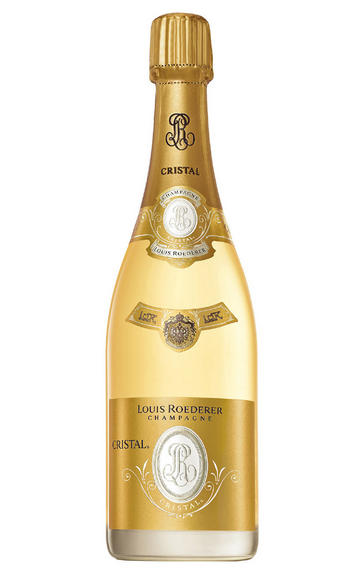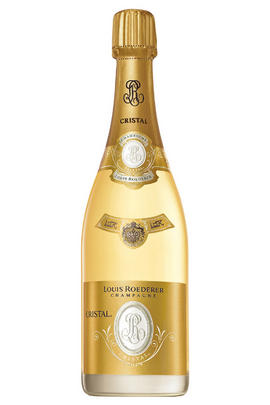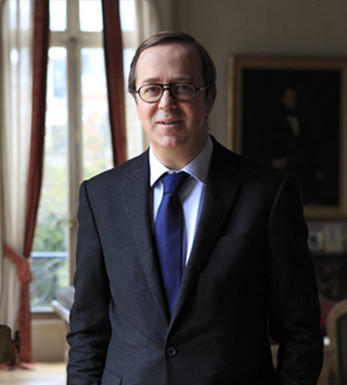
2013 Champagne Louis Roederer, Cristal, Brut

Critics reviews
The 2013 Cristal is a stunner. It takes themes first seen in the 2008 and amplifies them to grand effect. Lemon confit, marzipan, tangerine oil, spice and crushed rocks all race across the palate. The 2013 is a Champagne of energy and tension, but it also avoids any hint of austerity. It shares a real feeling of saline drive with the 2008, but also offers a bit more mid-palate richness.
The blend is 60% Pinot Noir (from Aÿ, Verzy, Verzenay, Beaumont-sur-Vesle) and 40% Chardonnay (Mesnil, Avize, Cramant). Chef de Caves Jean-Baptiste Lécaillon was especially selective and used only 30 out of the potential 45 plots that are typically available for Cristal. About 32% of the lots were done in oak, the rest in steel, with the malolactic fermentation blocked across the board. It was an October harvest, the sort of harvest that has become increasingly rare in Champagne. Lécaillon describes the summer as similar to 2012 in terms of summer heat but adds the vines were a month behind in their development from the beginning of the season.
The 2013 has always been a Cristal that marries elements of warm and cool seasons. That duality is what makes it so intriguing. Dosage is 8 grams per liter. Disgorged: 2021.
Drink 2028 - 2053
Antonio Galloni, Vinous.com (December 2023)
I've revisited Roederer's 2013 Cristal four times since I reviewed it in April of this year—including several times from my own cellar—and I had to admit that even my lavish praise didn't do it full justice. Combining the cool-vintage cut of 2008 with the more completely mature fruit of 2012, the 2013 Cristal might well be said to represent the perfect combination of the two from a purist's perspective.
The wine unwinds in the glass with notes of crisp orchard fruit, white flowers, almond paste and citrus oil, followed by a medium to full-bodied, seamless and multidimensional palate that's intense but weightless, with racy acids, a pinpoint mousse and a long, penetrating finish. Drink the 2008 Cristal on its own, and you're unlikely—to put it mildly—to have any complaints; but compare it directly with the 2013 and you'll see Roederer's rapid progress in the vineyards writ large.
Drink 2025 - 2060
William Kelley, Wine Advocate (September 2021)
Pale gold. Tiny bead. Intense nose of fresh almonds, lemon zest and blossom. Tight and tense with masses of acidity and freshness but not painfully so. Neat and a little introvert. This is clearly made up of many layers and is extremely persistent. A fine mix of intellectual and pleasurable. Pretty gorgeous.
Drink 2021 - 2035
Jancis Robinson MW, JancisRobinson.com (May 2021)
The palate here is very expressive and voluminous. Plenty of pinot-noir, sliced-strawberry flavor. Very rich and round and very assertive, this is so long and complete already. Pink fruit and berries in abundance and a sizzling, mineral finish. Fresh resolve here. Impressive!
Drink now or hold
James Suckling, JamesSuckling.com (September 2019)
Created in 1876 to satisfy the demanding tastes of Tsar Alexander II, Louis Roederer’s Cristal has since become a symbol of luxury all around the world. Produced only during the best years, it’s made from 60% Pinot Noir and 40% Chardonnay, the grapes coming from 45 of the finest lieux-dits in the region. 2013 was a late bloomer, with flowering only taking place in July after a cool spring. The summer was ideal with long periods of dry and warm weather. One third of the wine is aged in oak and there’s no malolactic fermentation.
Vincenzo Arnese: Packed with elegant yet powerful aromas of ripe orchard trees that merge with brioche and dry cookies. This is a harmonious and well-defined Champagne with integrated residual sugar and astonishing acidity. Divine!
Pedro Ballesteros Torres MW: Lemon coloured with a pink hue. Like a blanc de noirs, with cherries and white fruit aromas. Balanced and suave. Goes from less to more, with an exceptionally long and complex finish.
Amanda Barnes: Appealing notes on the nose of pastry dough and apple tart that are very open. On the palate there’s beautiful concentration with lingering savoury notes. Minerally and sophisticated. Nominated by Peter Liem
Drink 2023 - 2050
Vincenzo Arnese, Pedro Ballesteros Torres MW, Amanda Barnes, Decanter.com (December 2022)
I think the 2013 Cristal checks in behind the 2008, but it's nevertheless a beautiful wine. Lots of ripe orchard fruits, toasted bread, brioche, and chalky mineral notes define the nose, and it's medium to full-bodied, with a layered, nicely concentrated, tight, inward style, beautiful precision and purity, and a great finish. It needs a good 5-7 years of bottle age to hit its stride and will keep for two decades or more.
Drink 2026 - 2048
Jeb Dunnuck, JebDunnuck.com (May 2021)
About this WINE

Louis Roederer
Founded in 1776, Louis Roederer is a family-owned, independent Champagne house with a well-deserved reputation for quality. It is managed by Frédéric Rouzaud, the seventh generation to be at the helm.
In 1876, Louis Roederer created the now-famous Cristal at the request of Alexander II. This once intensely sweet wine is now one of the most luscious, deeply flavoured champagnes available, with the '88, '89 and '90 among the greatest Cristals ever released.
Louis Roederer’s best-selling non-vintage blend for almost 40 years, Brut Premier, has recently been replaced by Collection 242. This new multi-vintage blend was created by Chef du Caves Jean-Baptiste Lécaillon in response to increasingly warm vintages. The cuvée aims to capture freshness and is based on a perpetual reserve which focuses on acidity and minerality.

Brut Champagne
Brut denotes a dry style of Champagne (less than 15 grams per litre). Most Champagne is non-vintage, produced from a blend from different years. The non-vintage blend is always based predominately on wines made from the current harvest, enriched with aged wines (their proportion and age varies by brand) from earlier harvests, which impart an additional level of complexity to the end wine. Champagnes from a single vintage are labelled with the year reference and with the description Millésimé.
Non-vintage Champagnes can improve with short-term ageing (typically two to three years), while vintages can develop over much longer periods (five to 30 years). The most exquisite and often top-priced expression of a house’s style is referred to as Prestige Cuvée. Famous examples include Louis Roederer's Cristal, Moët & Chandon's Dom Pérignon, and Pol Roger's Cuvée Sir Winston Churchill.
Recommended Producers : Krug, Billecart Salmon, Pol Roger, Bollinger, Salon, Gosset, Pierre Péters, Ruinart

Champagne blend
Which grapes are included in the blend, and their proportion, is one of the key factors determining the style of most Champagnes. Three grapes are used - Pinot Noir, Chardonnay and Pinot Meunier.
26% of vineyards in Champagne are planted with Chardonnay and it performs best on the Côtes des Blancs and on the chalk slopes south of Epernay. It is relatively simple to grow, although it buds early and thus is susceptible to spring frosts. It produces lighter, fresher wines than those from Burgundy and gives finesse, fruit and elegance to the final blend. It is the sole grape in Blancs de Blancs, which are some of the richest long-lived Champagnes produced.
Pinot Noir accounts for nearly 40% of the plantings in Champagne and lies at the heart of most blends - it gives Champagne its body, structure, strength and grip. It is planted across Champagne and particularly so in the southern Aube district.
The final component is Pinot Meunier and this constitutes nearly 35% of the plantings. Its durability and resistance to spring frosts make the Marne Valley, a notorious frost pocket, its natural home. It ripens well in poor years and produces a soft, fruity style of wine that is ideal for blending with the more assertive flavours of Pinot Noir. Producers allege that Pinot Meunier lacks ageing potential, but this does not deter Krug from including around 15% of it in their final blends.


Buying options
Add to wishlist
Description
The 2013 Cristal is a stunner. It takes themes first seen in the 2008 and amplifies them to grand effect. Lemon confit, marzipan, tangerine oil, spice and crushed rocks all race across the palate. The 2013 is a Champagne of energy and tension, but it also avoids any hint of austerity. It shares a real feeling of saline drive with the 2008, but also offers a bit more mid-palate richness.
The blend is 60% Pinot Noir (from Aÿ, Verzy, Verzenay, Beaumont-sur-Vesle) and 40% Chardonnay (Mesnil, Avize, Cramant). Chef de Caves Jean-Baptiste Lécaillon was especially selective and used only 30 out of the potential 45 plots that are typically available for Cristal. About 32% of the lots were done in oak, the rest in steel, with the malolactic fermentation blocked across the board. It was an October harvest, the sort of harvest that has become increasingly rare in Champagne. Lécaillon describes the summer as similar to 2012 in terms of summer heat but adds the vines were a month behind in their development from the beginning of the season.
The 2013 has always been a Cristal that marries elements of warm and cool seasons. That duality is what makes it so intriguing. Dosage is 8 grams per liter. Disgorged: 2021.
Drink 2028 - 2053
Antonio Galloni, Vinous.com (December 2023)
wine at a glance
Delivery and quality guarantee